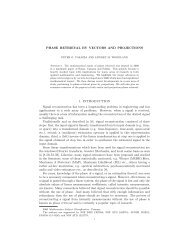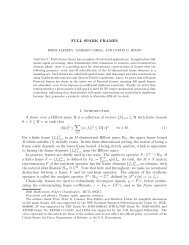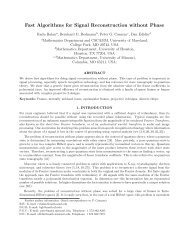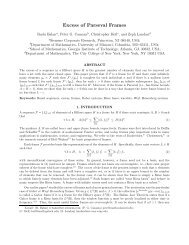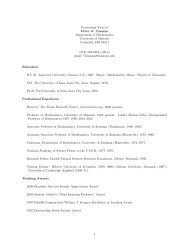Introduction to Finite Frame Theory - Frame Research Center
Introduction to Finite Frame Theory - Frame Research Center
Introduction to Finite Frame Theory - Frame Research Center
You also want an ePaper? Increase the reach of your titles
YUMPU automatically turns print PDFs into web optimized ePapers that Google loves.
<strong>Introduction</strong> <strong>to</strong> <strong>Finite</strong> <strong>Frame</strong> <strong>Theory</strong> 25<br />
Reconstruction from coefficients with respect <strong>to</strong> an orthonormal basis was already<br />
discussed in Corollary 1. However, reconstruction from coefficients with respect <strong>to</strong><br />
a redundant system is much more delicate and requires the utilization of another<br />
frame, called dual frame. If computing such a dual frame is computationally <strong>to</strong>o<br />
complex, a circumvention of this problem is the so-called frame algorithm.<br />
5.1 Exact Reconstruction<br />
We start with stating an exact reconstruction formula.<br />
Theorem 8. Let (ϕ i ) M i=1 be a frame for H N with frame opera<strong>to</strong>r S. Then, for every<br />
x ∈ H N , we have<br />
x =<br />
M<br />
∑<br />
i=1<br />
〈x,ϕ i 〉S −1 ϕ i =<br />
M<br />
∑<br />
i=1<br />
〈x,S −1 ϕ i 〉ϕ i .<br />
Proof. This follows directly from the definition of the frame opera<strong>to</strong>r in Definition<br />
17 by writing x = S −1 Sx and x = SS −1 x. ⊓⊔<br />
Notice that the first formula can be interpreted as a reconstruction strategy,<br />
whereas the second formula has the flavor of a decomposition. We further observe<br />
that the sequence (S −1 ϕ i ) M i=1 plays a crucial role in the formulas in Theorem 8. The<br />
next result shows that this sequence indeed also constitutes a frame.<br />
Proposition 13. Let (ϕ i ) M i=1 be a frame for H N with frame bounds A and B and<br />
with frame opera<strong>to</strong>r S. Then the sequence (S −1 ϕ i ) M i=1 is a frame for H N with frame<br />
bounds B −1 and A −1 and with frame opera<strong>to</strong>r S −1 .<br />
Proof. By Proposition 10, the sequence (S −1 ϕ i ) M i=1 forms a frame for H N with<br />
associated frame opera<strong>to</strong>r S −1 S(S −1 ) ∗ = S −1 . This in turn yields the frame bounds<br />
B −1 and A −1 . ⊓⊔<br />
This new frame is called the canonical dual frame. In the sequel, we will discuss<br />
that also other dual frames may be utilized for reconstruction.<br />
Definition 19. Let (ϕ i ) M i=1 be a frame for H N with frame opera<strong>to</strong>r denoted by S.<br />
Then (S −1 ϕ i ) M i=1 is called the canonical dual frame for (ϕ i) M i=1 .<br />
The canonical dual frame of a Parseval frame is now easily determined by Proposition<br />
13.<br />
Corollary 7. Let (ϕ i ) M i=1 be a Parseval frame for H N . Then its canonical dual<br />
frame is the frame (ϕ i ) M i=1 itself, and the reconstruction formula in Theorem 8 reads<br />
x =<br />
M<br />
∑<br />
i=1<br />
〈x,ϕ i 〉ϕ i , x ∈ H N .



